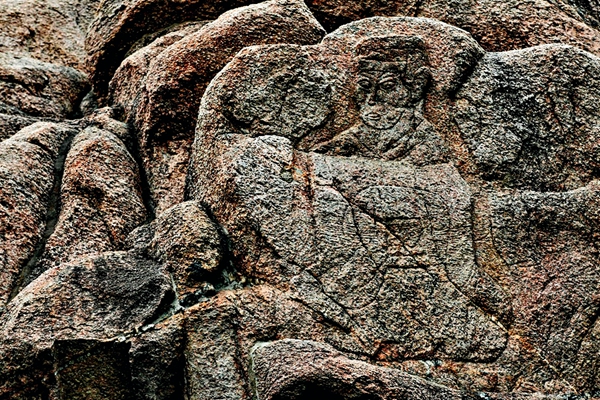Silent witnesses to emergence of Maritime Silk Road
- By staff reporter Dang Xiaofei
 0 Comment(s)
0 Comment(s) Print
Print E-mail China Today, July 28, 2017
E-mail China Today, July 28, 2017
In Lianyungang, a city on the eastern coast of China, is a hill known as Kongwang, which translates as "Confucius Contemplates," a name it received after the great philosopher Confucius (Kong Zi in Chinese) climbed it to contemplate (wang in Chinese) the sea. However, the most amazing thing about this small hill only 129 meters high is not that it was visited by one of the great Chinese thinkers, but that it hides a group of Buddhist carvings from the Eastern Han Dynasty (25-220). This is testimony to the arrival of Buddhism in the country through the Maritime Silk Road.
200 Years Older than the Mogao Grottoes
The figures can be seen from the paved road 500 or 600 meters west of the entrance at the foot of the hill. Carved into a yellow ocher rock, 105 figures of different sizes and positions tell Taoist and Buddhist stories. In fact, these images incorporate the secrets of the Maritime Silk Road.
|
A carving of Buddha on Kongwang Hill. |
Although the "picture" is dominated by Taoist figures, some Buddhist images can be found around them. This syncretism was a cultural particularity of the Eastern Han Dynasty, especially after Buddhism first entered China and took advantage of the local religion – Daoism – to spread. "The positions of the images and the carving techniques clearly reflect the Han style: full use of high relief and engraving with convex lines," explained Gao Feng, deputy director of Haizhou District Tourism Department in Lianyungang.
Opposite the Buddhist images, upon four lotus flowers – one under each foot – is an elephant carved in stone, from a single gigantic rock. "Both the elephant and the lotus flower are closely related to Buddhism," said Gao Feng. "They say that Sakyamuni Buddha rode an elephant before he was reincarnated. After his rebirth, Sakyamuni stepped on lotus flowers." Along with the images that decorate the rock, the stone elephant relates to a time when Buddhism spread through China and coexisted harmoniously with Taoism. Inside the left front leg of the elephant is written in characters: "Fourth month of the fourth year of the reign of Yongping." This date indicates the creation of the elephant, which took place during the rule of Liu Zhuang, second emperor of the Eastern Han Dynasty.
|
Many details have disappeared after centuries of weathering. |
In 1980, experts revealed that Kongwang Buddhist images were carved in the late Eastern Han Dynasty, 200 years before the Mogao Grottoes – known as the "China Grottoes" – were created.
How is it possible that such syncretism occurred first on the Kongwang Hill and not in the center and west of the country where Buddhist culture was most developed? The explanation has to do with the fact that in that area, in addition to living in a strong religious atmosphere, the Eastern Han Dynasty had fully developed the stone carving technique. However, another explanation points to the fact that, in parallel with the overland Silk Road, Indian Buddhism was introduced to China through the Maritime Silk Road.








Go to Forum >>0 Comment(s)